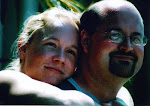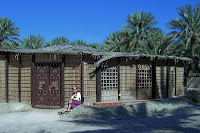
Christine in the middle of the oasis

Randy by the date palms

The clock roundabout
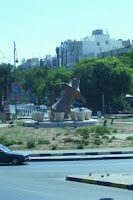
The coffee pot roundabout
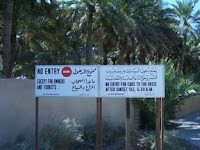
The entry into the oasis

Falaj, or irrigation tunnels

One of the many date palms
After a hearty breakfast Christine and I made our way to Abu Dhabi’s main bus station. The five-minute cab ride cost 5 dirhams ($1.35); the two-hour bus trip to Al-Ain cost ten dirhams (go figure). Years ago, this overland trek took five days by camel. Our journey took us from our bustling, skyscraper-indented island capital through the coastal plains and salt flats, gradually yielding to rolling sand dunes of brown and red. It’s no wonder that people—locals and tourons, er, tourists, alike—enjoy the desert around Al-Ain. Dune bashing, the not-so-eco-friendly act of crashing four-wheel drive vehicles up and over the dunes, is a popular pasttime for the thrill-seeker. Rollercoaster enthusiasts would love it, so I’m ready to do that soon.
The low-rise city of Al-Ain is home to numerous over-the-top roundabouts; their decorations are extreme: the huge, fake rock mountain, the gigantic coffee pot, the mammoth clock—all of these and more can be found in the middle of roundabouts throughout the city. In fact, it’s an effective navigational tool: Go past the coffee pot roundabout and turn right at the gazelle roundabout. If you pass the Arabian horse one, you’ve gone too far.
Al-Ain enjoys the distinction of being the birthplace of His Highness Sheikh Zayed bin Sultan Al Nahyan, the late founder and president of the United Arab Emirates and ruler of Abu Dhabi, the largest of the seven emirates that constitute this relatively-new country in eastern Arabia. After the discovery of oil in Abu Dhabi (the emirate, not the city), Sheikh Zayed poured money into the city of his birthplace, establishing a museum here (the first in the U.A.E.) and ensuring that, like Abu Dhabi city, there was some green in the town, in the form of parks, trees, and grass. An ancient oasis already, Al-Ain became even more of a gem in the sand, and a welcome respite for coastal city-dwellers seeking relief from the heat. Al-Ain is located along a wadi, a natural and mainly underground stream that nourishes the land. Centuries ago, people constructed irrigation tunnels, called falaj, to put the wadi to their own use. Today, descendants of these irrigation tunnels still transport water to the numerous date palms in the oasis.
After a lunch of delicious mutton and chicken curry at a small Indian café, we walked to this oasis. A sign in English welcomed us: NO ENTRY. EXCEPT FOR OWNERS AND TOURISTS. The idea, I believe, was to keep out local traffic, which could damage the fragile eco-system created in the harsh desert. Underneath the date palms, the oasis was definitely cooler—and quieter. We enjoyed the cooling breeze, the shade, the dearth of vehicles and that incessant honking. Occasionally, we would see the water flowing through the tunnels, although most tunnels were dry. A system of primitive dams had been constructed to control where the water flowed. We saw many birds, including this rather large bird with a beautiful blue streak on his wings.
The meandering paths led us, by chance, to a different exit, right next to the Al-Ain Royal Palace Museum, which we did not know existed. We were aware of the East Fort and its neighboring Al-Ain National Museum, near another entrance to the oasis, but this palace was a nice surprise. Built by Zayed after the oil boom as a home when in Al-Ain, the Royal Palace is now open to visitors. It offers a fascinating glimpse into the life of a royal, with many separate buildings, numerous courtyards, and various rooms for entertaining, sipping coffee, discussing matters important and/or trivial, and sleeping when the day is done. Cool and comfortable, nestled against the thick date-palm oasis, the palace has some charming gardens and ponds. I could certainly live there comfortably.
From the palace, Christine and I walked back through the oasis. One wrong turn later, we were at the East Fort, the actual birthsite of Sheikh Zayed, and the Al-Ain National Museum next door. The museum contains much information on the Emirates and Oman, from Stone-Age remnants to Bedouin life and culture. The museum includes photographs of Al-Ain and Abu Dhabi then and now, exhibits of clothing and silver and weaponry and pottery, and an interesting introduction to the Hili tombs, a Stone-Age archaeological site with many unanswered questions. As we left the museum, we heard music in the form of drum-beating and singing. Some local men had gathered to sing outside the East Fort, and we watched as they sang to the drumbeats and swayed and marched in time.
From the museum, we took a quick cab ride to the Omani border. Al-Ain becomes Buraimi in Oman, and guide books talked of easy entrance to Buraimi. Customs and immigration, the travel books said, were fifty kilometers down the road, so the physical border was very informal, even non-existent! The border official at the well-guarded gate, however, told us otherwise.
“No street for you,” he informed me. “Only for Gulf State nationals.”
“Residents?” I asked, hopefully.
He smiled the smile of a border guard who is about to say no. “No, just nationals.”
He then told me about acquiring a visa elsewhere and returning to a different border point to gain access. Otherwise, he told me, Oman was off limits. No wonder people prefer to fly into Oman rather than deal with land border crossings. Our flight into Muscat a month earlier was much easier.
We had wanted to stay at a hotel on the Buraimi side, where things were cheaper. The only hotels in Al-Ain are high-priced, five-star “palaces” which are fine if you intend to spend time at their resorts, but all we wanted was a place to lay our road-weary heads. Buraimi was also home to another fort of interest as well as a camel market, but it was getting late and we did not want to spend half the night trying to break through the iron curtain that comprised this “informal” border crossing. Another cab ride took us to the cheapest hotel in Al-Ain, where the cheapest rooms were about $100 a night. Those rooms were sold out, however, and all the hotel manager could offer us was a two-room suite. Resisting the urge to ask if there was a stable where we could stay, I told him no thanks. His smile was oddly reminiscent of the border guard’s smile; perhaps they were related. The manager seemed most pleased as he implied that I should have made a reservation. I would have been most pleased to give him a wedgie with his tie, while he was still wearing it.
Yet another cab ride took us to the bus station, which of course is right next door to the East Fort and the Al-Ain National Museum. We had not visited the zoo, the livestock souq, half of the crazy roundabouts, or anything in Buraimi, but we were heading home anyway. The bus driver took our dirhams and directed us, to my dismay, to the front seat, the unofficial women’s section of the bus. I assume he wanted to ensure that Christine was not sitting next to any strange men (besides me, of course). With our overnight weekend trip shortened to a long day trip, we headed back along the tree-lined highway to Abu Dhabi, tired but satisfied overall, thinking of our own bed and a good night’s slumber at home, content with the thought of sleeping late the next morning, and of course already planning our next trip.
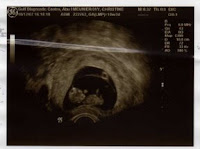

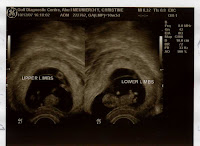






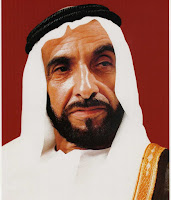
 Mutrah souk
Mutrah souk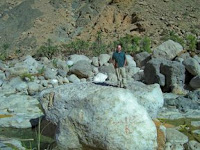 Wadi Tiwi
Wadi Tiwi Jabrin Castle
Jabrin Castle